

 Now you can keep up to date with us on the Virginia Lamb Blog... Our own special blog of farm life, recipes, and ag news that we think you will find interesting.
Now you can keep up to date with us on the Virginia Lamb Blog... Our own special blog of farm life, recipes, and ag news that we think you will find interesting.
Now you can find us on your favorite social network.



|
 |

|

|

Find what you are looking for? Have a question or suggestion? I would be happy to help you.

Janet Childs
Customer Service

Virginia LambTM
P.O. Box 784
Berryville, VA 22611

info@virginialamb.com

|

|

|
|
We are changing formats on how we post monthly feeds. We will now be adding all farm happenings to our new blog. In the meantime, below is a look at farm life over the span of a year. As you can see, the chores are many, but the rewards are great!
December

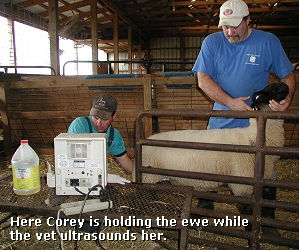 The vet was here today to properly set the stage for the new year! We ultrasounded 78 head of sheep. The first group of Suffolks will lamb between January 17th and February 9th, with smaller groups lambing in March and again in the month of April.
The vet was here today to properly set the stage for the new year! We ultrasounded 78 head of sheep. The first group of Suffolks will lamb between January 17th and February 9th, with smaller groups lambing in March and again in the month of April.

The good news... only three sets of triplets this year! Yeah!! Last year we had 4 sets of triplets and 1 set of quadruplets. Not necessarily a bad thing when income is based on total number of head raised, BUT each ewe (female sheep) naturally has two teats. And it has been our experience, that one lamb per faucet seems to keep everyone the happiest!

The Southdowns are now on easy street getting the main section of the barn to relax and enjoy their last month of pregnancy. At this point it is pretty easy to see they are stuffed full of babies. Most of the blackface ewes have been put back out to winter pasture. We've kept a small group close to home that are either due first, having triplets, or are a little thinner due to age. These girls will get a little extra TLC until lambing.

FYI: Livestock in general have a tendency to get stressed when being handled. How do we prevent this? First, we do our best to minimize the time they are being handled and that they are handled with plenty of patience and in a calm atmosphre. (Most who have visited our barn comment on how easy going our sheep are!) All of them have their own personalities. The best comparison would be you giving your family dog a bath... some just love the extra attention and then there are those who just grit their teeth waiting for the whole ordeal to be over. To make sure more of our sheep enjoy it than don't, we feed a little extra grain before and after to keep it a positive experience for all.
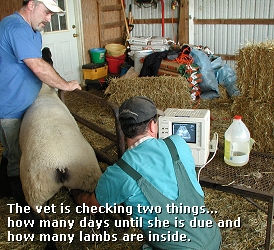 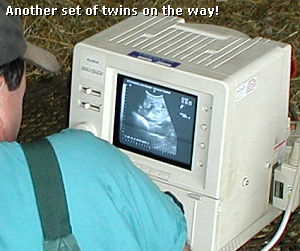
November

We've moved the mature blackface ewes to our winter pasture. This does two things. First, it is a clean pasture (meaning it hasn't had sheep on it for over 10 months) which helps to control parasite loads and reduce the amount of wormer we have to give. Second, after a heavy frost, fescue
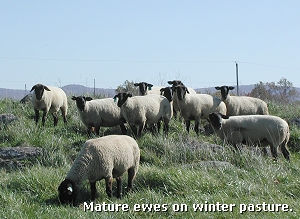 becomes very palatible and the sheep love it. And because the pasture has not been grazed during the summer months, there is an abundance of grass that will last throughout the fall.
becomes very palatible and the sheep love it. And because the pasture has not been grazed during the summer months, there is an abundance of grass that will last throughout the fall.

They will stay on pasture through December at which time they will be brought back to the barn and grouped and managed according to due dates and number of lambs expected. The Southdowns should begin lambing in late December and everyone else in mid January. We did decide to expose (breed) a couple of ewe lambs late this fall. They will not begin lambing until March and April.
October

Another year at the Virginia State Fair has come and gone.

From now until the end of December things really begin to slow down out at the barn. We will ultrasound all the ewes in early December to nail down due dates and multiple births. Now it becomes a waiting game!

Last month we encountered mechanical problems with the tractor, so it is now in the shop awaiting a new engine. Once repaired we will begin our regular fall barn cleaning and transporting all the large round bales of hay back to the main farm for the winter.
September

Breeding season is here! After lambing season, this is our second favorite time of year. It's like planting seeds in a garden and anticipating a future harvest. Corey and I will actually sit down and review all the ewes in the flock and hand select which ram they will be bred too. Although we have chosen to sell less lambs as show sheep... our competitive nature just can't help but get excited about that next great show lamb! All totalled we will be breeding close to 80 ewes this fall. We had hoped to increase our numbers more significantly this year by purchasing additional ewes, but with the draught and increasing feed costs, we decided to wait it out a bit longer. We will, however, be adding several of our own ewe lambs back to the flock.
August

The effects of the draught couldn't be clearly. Today we lost use of the fall pasture we rent because of no grass. We've been feeding hay off and one for over a month now, but loosing access to the pasture that runs us through January really hurt. If (and it's a big if) we get rain soon... we might be able to move the ewes back. Already feeding hay that was put away for this winter is a bit scarry too. Because of the size of our operation it is cheaper for us to buy hay than to invest in costly equipment to make it ourselves. However, our budget is definitely feeling the strain of higher prices due to the drought. Pray for rain soon!
Our county fair was last week... What fun!! Any of you looking for an excuse to exit the city and spend the day with your kids should schedule a trip to the Clarke County Fair! It is a time to see old friends and meet new ones, eat food you shouldn't, and simply enjoy... But it was exhausting. I think the kids had a show just about every day. Monday we brought animals to the fairgrounds and weighed everything in. Tuesday was the Sheep Show in the morning and the Goat Show in the evening. Wednesday was the Beef Show. Thursday the Pig Show. Friday we had fun games for all the kids and then Saturday was the day the kids sold their projects at the Clarke County Fair Livestock Sale.
Our kids did very well... They exhibited and sold the Reserve Champion Bred & Owned Market Lamb, Champion Britsh Cross Steer, and Champion Shorthorn Steer.
Is it possible that the summer is almost over? Our county fair begins next week and the kids will be exhibiting all the animals that they have so diligently being working with all summer.
In the next couple of weeks we will be getting the ewes in to worm, vaccinate, and check for any health problems. Breeding season will be here before we know it!
June / July

Life is good! With our oldest daughter being able to drive, more and more of the farm chores are being given to the kids. We still visit the barn everyday to keep everyone on tasks but I can focus much more on getting ready for the farmers markets.
We've moved the ewes to another of our rented pastures and will keep them there from no until breeding time.
May

All the lambs have been weaned with the exception of a few belonging to yearlings who we saved and lambed in March and April. Life is just about back to normal... and just in time for the farmers markets to hit full stride! This is the time of year that we clean out the barn, fix fence, making minor repairs to equipment, and catch up on all those things we've put off before it gets too hot. We've had a cooler than average spring and had to feed hay a little longer than anticipated but the grass is finally growing.
The kids are beginning to work hard on 4-H projects. At last count we had 3 steers, 5 hogs, 3 goats, and 9 lambs that the kids are raising as their fair projects. Not only are the kids responsible for feeding their animals twice a day, but each animal must be halter broke (with exception of the pigs) and records on all expenses and hours worked must be kept.
April 2007

Today marks the day in past years that we have sold most of our lambs to 4-H kids to exhibit as projects at their county fairs. This year we have decided to keep back almost all of our lambs to raise and sell at farmers markets to keep up with growing demand. Great news for our retail customers... not so great news for our feed salesman. This means pushing back the time when we will sell lambs and delaying income.
Traditionally we have sold lambs this time a year giving us 80% of our income. Likewise 80% of our feed costs are incurred during early spring when the ewes are lactating. Because we lamb in early spring, high quality hay and grain supplementation is necessary to keep the ewes milking strong. Although the farmers markets will definitely give us a more steady income stream, it will be an adjustment during these first few years.
The count down has begun for weaning some of the lambs off their moms. For a couple of days the ewes will be dry lotted (limited water and feed) to dry off milk production completely. We will also check udders several times during this period to make sure no one comes down with mastitis, then the ewes will go back out to one of our rented pastures full time. Lambs will then be grouped based on weight and age and given room to play, eat, and be merry.
March

Who would have thought such a simple task as updating a web site could be so challenging. I profusely apologize for the delays... I guess I am doing good just to remember what day of the week it is.
Work on the farm has been increasingly busy. We have momma ewes and lambs in every pen in the barn and are making smaller make shift pens on the fly. Although the bulk of our lambs are now on the ground (have been born), we are still at the barn more hours than not. The only thing worse than getting in the way of a pregnant ewe and her meals is getting in the way of a milking ewe and her dinner. Because our ewes generally milk very well, we feed both morning and night and sometimes additional hay mid-day. We have a couple of bottle babies we are caring for as well as a new born kid (baby goat) whose mom came down with pregnancy toxemia and we lost her.
February

Lambing season is now in full swing and emotions vary drastically between highs and lows. We've had anywhere between two to nine lambs born everyday since the first of the month, including two sets of triplets and a set of quads.
Unfortunately, with these record breaking cold temperatures we've lost a few lambs as well. The first 24 hours is critical to their survival and although the barn is quite a bit warmer than outside, single digit temperatures can be a shepherd's enemy.
 On top of sleepless nights and fridged air, we had a fox attack last week. It appears that during the night a fox got into the barn and stole a lamb away from a mother as she was lambing. Although we lost the lamb, Star, our faithful LDG (livestock guard dog), was there. When we got to the barn, we noticed that Star was not inside with the sheep, but sitting out in the pasture behind the barn. Though he seemed eager to listen, he refused to come when called. When Corey went to him, he found that Star was laying next to the dead baby lamb attempting to keep it warm. The fox, was several feet away, dead as well. Even though the story did not have a happy ending, it is apparent that Star did all that he could. And we praised him for his efforts.
On top of sleepless nights and fridged air, we had a fox attack last week. It appears that during the night a fox got into the barn and stole a lamb away from a mother as she was lambing. Although we lost the lamb, Star, our faithful LDG (livestock guard dog), was there. When we got to the barn, we noticed that Star was not inside with the sheep, but sitting out in the pasture behind the barn. Though he seemed eager to listen, he refused to come when called. When Corey went to him, he found that Star was laying next to the dead baby lamb attempting to keep it warm. The fox, was several feet away, dead as well. Even though the story did not have a happy ending, it is apparent that Star did all that he could. And we praised him for his efforts.
I've been trying to capture a ewe lambing on film to include here on the web site. Unfortunately, everytime I go out to the barn with the camera, I spend more time helping the ewe than taking pictures. I'll keep trying to get better shots, until then... Click Here to View Ewe Lambing.
January

Well we have finished lambing out all of the Southdowns... and the Suffolk ewes have started. Our oldest daughter, Kayla is in charge of newborns and making sure they get a good start in life. All of the lambs naturally nurse their mothers, however, from time to time, we will supplement slower lambs with a bottle.

After each ewe gives birth she will spend 2-3 days in a small pen called a lambing jug. This allows her individual time with her lambs to bond as they get their land legs under them. From there she will be mixed in with two or three other momma ewes, allowing them all time to identify their own lambs and socialize. From there they are then moved to an even larger mixing pen with the rest of the mommas and lambs.

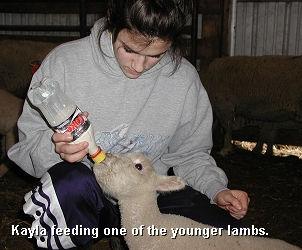 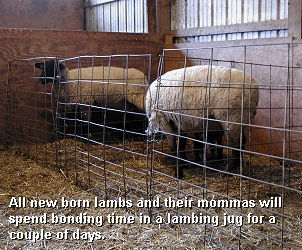

With so much going on at the barn this time of year, there are plenty of chores for every one in the family... whether it be filling up watering troughs, collecting eggs from our free range chickens, or feeding hay. We've been lucky so far with the weather being so mild. Once it gets back to true January weather, we will be going out to the barn to check sheep and the lambs every three hours in shifts around the clock.

Although most of the ewes do an excellent job getting the lambs dried off after birth, there is really a small window before the lambs can get chilled. In colder weather, lambs born have roughly 20-30 minutes to get up and begin nursing. They are born with very little stored body fat and require colostrum (a mother's first milk) as soon as possible. As a matter of fact, we will get extra colostrum from a local dairy farm to keep on hand in the freezer. This way should a ewe not let her milk down immediately after birth, we are able to supplement the lamb and get it going.

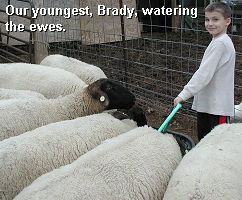 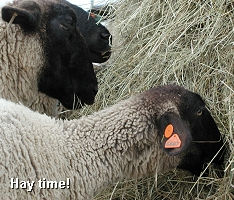 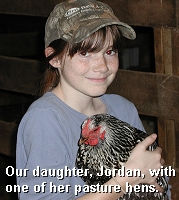
|
Virginia LambTM

The Childs Family ~ P.O. Box 784 ~ Berryville, Virginia 22611

e-mail info@virginialamb.com
Copyright 2011-2005. All Rights Reserved. Web Site Designed by Janet Childs
|

